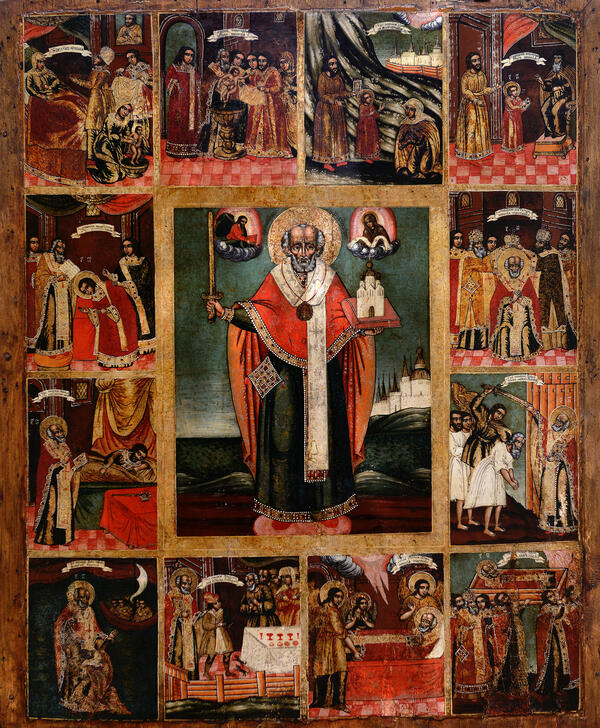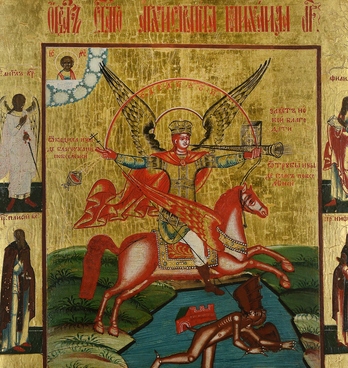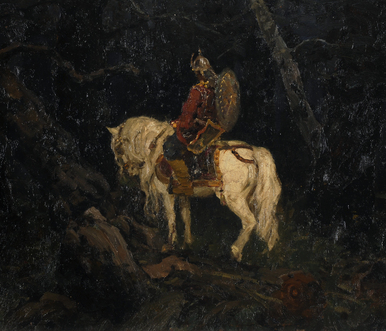The image of Nikola of Mozhaysk is based on the wooden monument of Nicholas the Wonderworker which was kept in the Mozhaysk Kremlin for a long time. This image was one of the most venerated images in Rus'. It was frequently referenced in folklore. According to the legend, the image appeared at the request of MozhAysk residents when the city was besieged by invaders. A formidable figure of the saint with a sword appeared in the sky and prevented the enemies from taking the city.
The image from the NovosibIrsk State Art Museum collection is considered a hagiography icon. This special icon type has been known since the 13th century. They were particularly popular in the times of icon painter Dionisius in the 15th-16th centuries. As a rule, in hagiography icons, the image of the saint is surrounded by a frame of smaller pictures. They depict events of his hagiography and the miracles he worked. These icons were particularly in demand since they helped believers get a clearer idea of the saint’s life.
The cult of St. NIcholas spread in Rus with the adoption of Christianity. At the same time, Russian hagiographic literature dedicated to him was developing gradually. The saint lived in the years of early Christianity. He was the bishop of MYra, a town in Asia Minor, and became famous for his pious deeds and working miracles. People turned to him for help and relied on him in their plights. They would say: “Nicholas helps you at the sea, Nicholas helps a man lift his cart”.
According to the canon, the icons depicted him as a wise elder with a high forehead and in bishop attire. The image from the Novosibirsk collection has a sword and a “city” in his hand. This particular type of iconography is known as “NikOla of Mozhaysk.”
The icon depicts this image quite accurately. It can be seen in both the saint’s pose and the color of his clothing. Nicholas is surrounded by smaller paintings called hagiographic kleimos. Among the scenes in kleimos, we can see Christmas, baptism, and many other events.
The image embodies the idea of protection and patronage. In memory of how the saint defended the city, a wooden statue of Nicholas holding a sword and a city was erected. Until 1933, it was located in St. Nicholas Cathedral in Mozhaysk. It is now stored in the State Tretyakov Gallery.
The image from the NovosibIrsk State Art Museum collection is considered a hagiography icon. This special icon type has been known since the 13th century. They were particularly popular in the times of icon painter Dionisius in the 15th-16th centuries. As a rule, in hagiography icons, the image of the saint is surrounded by a frame of smaller pictures. They depict events of his hagiography and the miracles he worked. These icons were particularly in demand since they helped believers get a clearer idea of the saint’s life.
The cult of St. NIcholas spread in Rus with the adoption of Christianity. At the same time, Russian hagiographic literature dedicated to him was developing gradually. The saint lived in the years of early Christianity. He was the bishop of MYra, a town in Asia Minor, and became famous for his pious deeds and working miracles. People turned to him for help and relied on him in their plights. They would say: “Nicholas helps you at the sea, Nicholas helps a man lift his cart”.
According to the canon, the icons depicted him as a wise elder with a high forehead and in bishop attire. The image from the Novosibirsk collection has a sword and a “city” in his hand. This particular type of iconography is known as “NikOla of Mozhaysk.”
The icon depicts this image quite accurately. It can be seen in both the saint’s pose and the color of his clothing. Nicholas is surrounded by smaller paintings called hagiographic kleimos. Among the scenes in kleimos, we can see Christmas, baptism, and many other events.
The image embodies the idea of protection and patronage. In memory of how the saint defended the city, a wooden statue of Nicholas holding a sword and a city was erected. Until 1933, it was located in St. Nicholas Cathedral in Mozhaysk. It is now stored in the State Tretyakov Gallery.



